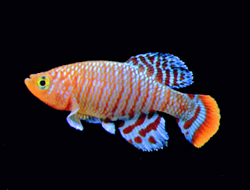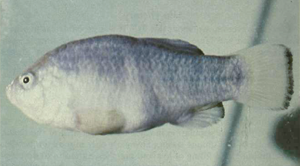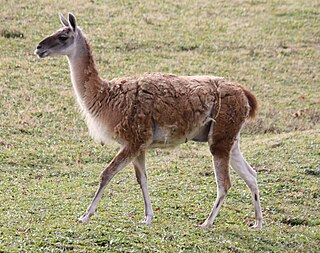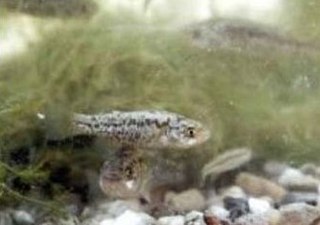
Lake Titicaca is a large freshwater lake in the Andes mountains on the border of Bolivia and Peru. It is often called the highest navigable lake in the world. Titicaca is the second largest lake in South America, both in terms of the volume of water and surface area. It has a surface elevation of 3,812 m (12,507 ft).

A killifish is any of various oviparous (egg-laying) cyprinodontiform fish, including families Aplocheilidae, Cyprinodontidae, Fundulidae, Nothobranchiidae, Profundulidae, Aphaniidae and Valenciidae. All together, there are 1,270 species of killifish, the biggest family being Rivulidae, containing more than 320 species. As an adaptation to living in ephemeral waters, the eggs of most killifish can survive periods of partial dehydration. Many of the species rely on such a diapause, since the eggs would not survive more than a few weeks if entirely submerged in water. The adults of some species, such as Kryptolebias marmoratus, can additionally survive out of the water for several weeks. Most killifish are small, measuring from 2.5 to 5 centimetres, with the largest species growing to just under 15 centimetres (6 in).

Lake Poopó was a large saline lake in a shallow depression in the Altiplano in Oruro Department, Bolivia, at an altitude of approximately 3,700 m (12,100 ft). Due to the lake's length and width, it made up the eastern half of Oruro, known as a mining region in southwest Bolivia. The permanent part of the lake body covered approximately 1,000 square kilometres (390 sq mi) and it was the second-largest lake in the country. The lake received most of its water from the Desaguadero River, which flows from Lake Titicaca at the north end of the Altiplano. Since the lake lacked any major outlet and had a mean depth of less than 3 m (10 ft), the surface area differed greatly seasonally.

The Tecopa pupfish is an extinct subspecies of the Amargosa pupfish. The small, heat-tolerant pupfish was endemic to the outflows of a pair of hot springs in the Mojave Desert of Inyo County, California. Habitat modifications, the introduction of non-native species and hybridization with the related Amargosa River pupfish led to its extinction around 1979.

The Uru or Uros are an indigenous people of Bolivia and Peru. They live on a still-growing group of about 120 self-fashioned floating islands in Lake Titicaca near Puno. They form three main groups: the Uru-Chipaya, Uru-Murato, and Uru-Iruito. The Uru-Iruito still inhabit the Bolivian side of Lake Titicaca and the Desaguadero River.

Lake Junin or Chinchaycocha is the largest lake entirely within Peruvian territory. Even though Lake Titicaca has a much larger area, its eastern half is located on Bolivian territory. Lake Junin is an important birdwatching destination in the country.

Pupfish are a group of small killifish belonging to ten genera of the family Cyprinodontidae of ray-finned fish. Pupfish are especially noted for being found in extreme and isolated situations. They are primarily found in North America, South America, and the Caribbean region. As of August 2006, 120 nominal species and 9 subspecies were known. Several pupfish species are extinct and most extant species are listed. In the U.S., the most well-known pupfish species may be the Devils Hole pupfish, native to Devils Hole on the Nevada side of Death Valley National Park. Since 1995 the Devils Hole pupfish has been in a nearly steady decline, where it was close to extinction at 35–68 fish in 2013.

The Titicaca grebe, also known as the Titicaca flightless grebe or short-winged grebe, is a grebe found on the altiplano of Peru and Bolivia. As its name implies, its main population occurs on Lake Titicaca. Lake Uru Uru and Poopó, the Rio Desaguadero, and small lakes that connect to Lake Titicaca in wet years, serve as "spillovers" territory. In the past, the population was larger and several of these lakes – such as Lakes Umayo and Arapa – apparently had and may still have permanent large colonies. It is sometimes placed in Podiceps or a monotypic genus Centropelma. Its local name is zampullín del Titicaca.

Orestias is a genus of pupfish. Older systematics classified them into the own family Orestiidae. They are found in lakes, rivers and springs in the Andean highlands of South America, and several species are considered threatened. They are egg-laying fish that feed on small animals and plant matter. The largest species can reach a total length of 27 cm (10.6 in), but most remain far smaller. Their most characteristic feature is the absence of the ventral fin, although this is shared by a few other pupfish. Despite their moderate to small size, they are important to local fisheries and a few species are farmed.

The fauna of the Andes, a mountain range in South America, is large and diverse. As well as a huge variety of flora, the Andes contain many different animal species.

Laguna de Cotacotani or Quta Qutani is a lake located in the Andean Altiplano of the Parinacota Province, Arica-Parinacota Region, Chile. It lies 4 km northwest of Chungará Lake, which is one of the highest lakes in the world and is surrounded by several volcanoes, such as the Payachata volcanic group, Sajama volcano and Wallatiri.
Waru Waru is an Aymara term for the agricultural technique developed by pre-Hispanic people in the Andes region of South America from Ecuador to Bolivia; this regional agricultural technique is also referred to as camellones in Spanish. Functionally similar agricultural techniques have been developed in other parts of the world, all of which fall under the broad category of raised field agriculture.

Telmatobius culeus, commonly known as the Titicaca water frog or Lake Titicaca frog, is a medium-large to very large and endangered species of frog in the family Telmatobiidae. It is entirely aquatic and found only in the Lake Titicaca basin, including rivers that flow into it and smaller connected lakes like Arapa, Lagunillas and Saracocha, in the Andean highlands of Bolivia and Peru. In reference to its excessive amounts of skin, it is sometimes jokingly referred to as the Titicaca scrotum frog.

Empetrichthys latos is a rare species of fish in the family Goodeidae, the splitfins. It is known by the common names Pahrump poolfish and Pahrump killifish, the former being more correct today. It is endemic to Nevada in the United States, where it was limited to the Pahrump Valley near the California border. It nearly became extinct due to habitat destruction and no longer occurs there. It is a federally listed endangered species of the United States. The Pahrump Poolfish is long-lived for a small-bodied fish, with ages up to 10 years for females and 7 years for males documented.

Lake Tauca is a former lake in the Altiplano of Bolivia. It is also known as Lake Pocoyu for its constituent lakes: Lake Poopó, Salar de Coipasa and Salar de Uyuni. The lake covered large parts of the southern Altiplano between the Eastern Cordillera and the Western Cordillera, covering an estimated 48,000 to 80,000 square kilometres of the basins of present-day Lake Poopó and the Salars of Uyuni, Coipasa and adjacent basins. Water levels varied, possibly reaching 3,800 metres (12,500 ft) in altitude. The lake was saline. The lake received water from Lake Titicaca, but whether this contributed most of Tauca's water or only a small amount is controversial; the quantity was sufficient to influence the local climate and depress the underlying terrain with its weight. Diatoms, plants and animals developed in the lake, sometimes forming reef knolls.
Lake Mataro is an ancient lake in the Andes. It formed over the northern Altiplano at an altitude of 3,950 metres (12,960 ft) and extended over the central Altiplano. It is one of the ancient lakes of the Altiplano like Lake Minchin, Lake Ballivian and Lake Cabana. It existed between 2.8 and 1.8 million years ago.
Lake Ballivián is an ancient lake in the Altiplano of South America and is named after the Bolivian scholar Don Manuel Vicente Ballivian. It is part of a series of lakes which developed in the Titicaca basin along with Lake Mataro and Lake Cabana, reaching an altitude of 3,860 metres (12,660 ft). Lake Ballivián itself is of late Quaternary age and may have influenced the spread and development of animals in the Altiplano. In the southern Altiplano, Lake Escara may be coeval with Lake Ballivián.

Odontesthes bonariensis is a species of Neotropical silverside, an euryhaline fish native to fresh, brackish and salt water in south-central and southeastern South America, but also introduced elsewhere. It is often known by the common name Argentinian silverside or pejerrey, but it is not the only species of silverside in Uruguay and Argentina and pejerrey is also used for many other silversides. It is a commercially important species and the target of major fisheries.

Chungará is a lake situated in the extreme north of Chile at an elevation of 4,517 metres (14,820 ft), in the Altiplano of Arica y Parinacota Region in the Lauca National Park. It has a surface area of about 21.5–22.5 square kilometres (8.3–8.7 sq mi) and has a maximum depth of about 26–40 metres (85–131 ft). It receives inflow through the Río Chungara with some minor additional inflows, and loses most of its water to evaporation; seepage into the Laguna Quta Qutani plays a minor role.

Aphaniidae, the Oriental killifishes, are a family of the order Cyprinodontiformes. The 42 extant species of the family inhabit inland waters, rivers and lagoons. The distribution of these species extends from the entire Mediterranean region throughout the neighboring states of the Red Sea and Persian Gulf to southwest India. Several species in this family have very small distributions and are seriously threatened.


















